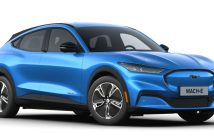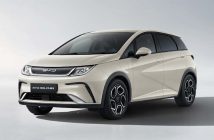+++ The United States Trade Ambassador, Katherine Tai, responded to CHINA ’s World Trade Organisation consultation request with harsh criticism. She says that not only is the country using unfair practices to undermine fair competition but it also leverages non-market practices and policies. The request to the WTO is still in limbo but could lead to changes in the act or other countermeasures. China argues that the Inflation Reduction Act (IRA) unfairly tilts the playing field and discriminates when it comes to electric vehicles. This complaint arises after the US restricted the number of electric cars that qualify for a clean vehicle tax credit up to $7,500 if their critical minerals or battery components were sourced from “foreign entities of concern”, including companies from China, Russia, North Korea and Iran. That’s why it’s levied a consultation request with the WTO. Ambassador Tai’s remarks come as a direct denunciation of that consultation request. “The Inflation Reduction Act is a groundbreaking tool for the United States to seriously address the global climate crisis and invest in U.S. economic competitiveness. It is our contribution to a clean energy future that we are collectively seeking with our allies and partners”, Tai said. No doubt, to a degree, the act has forced some companies to change plans so that their products can take full advantage of the tax credits offered. Tai then took to calling out China’s behavior in her view. “Meanwhile, the People Republic of China (PRC) continues to use unfair, non-market policies and practices to undermine fair competition and pursue the dominance of the PRC’s manufacturers both in the PRC and in global markets. The United States will also continue to work with allies and partners to address the PRC’s unfair, non-market policies and practices”, she concluded. All of this hullabaloo could amount to very little aside from political wrangling. This dispute could take quite a while to conclude. If the WTO were to find in favor of China, it’s likely that the U.S. would appeal that decision. Of course, appealing would take extra time since the appeals board has been defunct since 2019 when the U.S. opposed its judge appointments. Notably, China isn’t the only foreign nation with negative feelings about the IRA. Japan, South Korea and the European Union have all voiced concern over the act. However, Tai sees things differently: “The Inflation Reduction Act is a groundbreaking tool for the United States to seriously address the global climate crisis and invest in U.S. economic competitiveness. It is our contribution to a clean energy future that we are collectively seeking with our allies and partners. Meanwhile, the PRC continues to use unfair, non-market policies and practices to undermine fair competition and pursue the dominance of the PRC’s manufacturers both in the PRC and in global markets. Under president Biden’s leadership, we are tackling the climate crisis while strengthening America’s supply chains and energy security. We are building a clean energy economy, powered by American innovators, workers and manufacturers that will create good-paying union jobs and cut the pollution that drives climate change and environmental injustice. Through this bold action, the United States will continue to pursue major new investments in clean energy technology, from solar and wind to batteries and electric vehicles and beyond. The United States will also continue to work with allies and partners to address the PRC’s unfair, non-market policies and practices”. +++
+++ Electric cars, bikes and scooters, but also smartphones, tablets and computers. Batteries are now everywhere, all around us and silently becoming part of our daily lives. But above all, they are the key to the transition away from fossil fuels. EUROPE is therefore striving to become independent of Asia, the continent that currently supplies most of the raw materials and finished batteries. The European Union’s 2 latest initiatives are Battery Regulation and the Critical Raw Materials Act. Let’s find out about them: The first initiative is a regulation that was finally approved in July 2023 and came into force last February. It provides for a series of regulations covering the entire life cycle of batteries: from production to recycling, including use and re-use. The aim is to ensure that batteries are safe, durable and competitive. The rules apply equally to all types of batteries: those used in vehicles, electronic devices, industry, lighting and ignition systems. At the heart of the battery regulation are the minimum targets that manufacturers must meet for the collection of waste (i.e. end-of-life batteries): 63% by 2027 and 73% by 2030. The standards are 51% by 2028 and 61% by 2031 for vehicle batteries. There are also targets for lithium recovery (50% by 2027 and 80% by 2031) and minimum levels of recycled content that batteries must meet: 16% for cobalt, 85% for lead, 6% for lithium and 6% for nickel. For nickel-cadmium batteries, the target is 80% by 2025. Among other things, the regulation requires users to be able to remove and replace batteries. There are also performance, durability and safety criteria, as well as restrictions on hazardous substances such as mercury, cadmium and lead. Finally, there are requirements for labelling and information on components and recycled content. An “electronic battery passport” and a QR code are also being introduced. The second initiative is a law on critical raw materials (Crma). Its aim is to guarantee a secure and sustainable supply of minerals useful for transition. It contains a list of raw materials (34) and strategic materials (17), and sets benchmarks for covering annual consumption of raw materials: 10% for extraction, 40% for refining on the Old Continent and 25% for recycling. There is also talk of simplifying authorisations: a maximum of 27 months for extraction projects and 15 months for recycling and processing projects. “In order to facilitate the development of strategic projects, the European institutions specify that the Member States will set up single points of contact at the appropriate administrative level and at the relevant stage in the value chain of critical raw materials”. +++
+++ Stellantis, the maker of FIAT cars, on Wednesday signed further deals with unions in Italy for voluntary layoffs, meaning the automaker could cut its workforce by a total of over 3.000 roles in the country. New deals were reached on Wednesday for over 1.000 layoffs at facilities in Italy, including Melfi, Pomigliano d’Arco and Termoli, both for line workers and other functions, the FIOM union said in a statement, although it has not itself signed the agreements. The cuts are being driven in part by the transition to cleaner energy in the industry. They add to similar deals announced on Tuesday for Stellantis operations in the city of Turin, with as many as over 1.500 voluntary layoffs, and for the engine making facility in Pratola Serra, with 100 additional jobs involved. A deal has not yet been signed for the Cassino plant, another large Stellantis assembly facility in Italy. The company has proposed 850 voluntary redundancies for that site, FIOM had said on Tuesday, but a final deal with unions is expected to settle on a lower figure. Another agreement is expected to cover the Atessa van making plant in central Italy. A spokesman for Stellantis confirmed the new deals signed on Wednesday, under a framework agreed with unions last week. “They are part of the initiatives implemented by Stellantis to address the effects of the ongoing energy and technology transition process, including on employment”, the spokesman said. They are on a strictly voluntary basis and mostly aimed at employees close to retirement age or willing to take new professional opportunities, the spokesman reiterated. Stellantis employs about 43.000 people in Italy, including about 15.000 in the area of Turin, in Italy’s northwest, the historic home of Fiat, which merged with Peugeot SA to create Stellantis. Voluntary redundancy packages have been the main tool used by Stellantis to cut its workforce in Italy, which amounted to around 55.000 people when the group was formed in early 2021. The carmaker, which on Wednesday reiterated Italy had a central role to play in its global operations, is in talks with the Italian government on conditions allowing it to boost its annual output in the country to 1 million vehicles, from about 750.000 last year. +++
+++ FORD may have revealed the original 1964 Mustang in New York, but it’s not showing the 60th anniversary car there. Instead, all Ford is providing is a teaser of the special edition car, and all it shows is the badging. As you can see, it will consist of pentagonal badges in red and black that will be featured on the tail and fenders. They’ll replace and incorporate aspects of the standard badging such as the ‘5.0’ fender numbers and ‘GT’ on the rear of the main V8 trim. Ford further noted that it will strictly be an appearance package. Presumably available both on the GT and the Ecoboost 4-cylinder models, though Ford didn’t specify. We won’t get to see the actual car until April 17, the same date the original Mustang was revealed 6 decades ago. The reveal will be at Charlotte Motor Speedway. At the event, attendees will get to see various modified and racing Mustangs, and go for ride-alongs on the track. +++
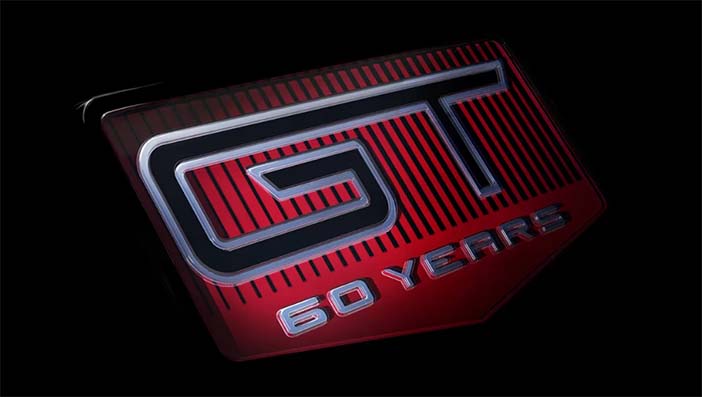
+++ MCLAREN ’s design has come a long way since the launch of the 12C, a car that looked old before it had even arrived in showrooms. But the company is about to overhaul its entire design process, introducing a new design language and today, it’s given us the first taste of what’s coming up. The supercar maker released just one outline image of a supercar in profile that is hardly the most revealing to those of us who aren’t design graduates. But it also explained in some detail the five new principles that will shape the look and feel of every future McLaren model. The company also released pictures and sketches from its back catalog to help us understand how future models will take inspiration without falling down a retro rabbit hole. Tobias Sühlmann, who recently returned to McLaren as design boss following a spell at Bentley, oversaw the development of the new ‘Performance by Design’ philosophy, which the company claims won’t only answer criticisms that the cars have looked too similar, but also be versatile enough to work with cars in “new segments and with future powertrain technologies”. Yes, that’s a coded reference to EVs and SUVs.
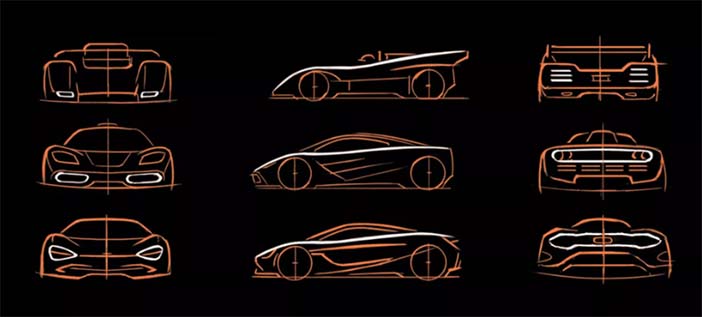
Design elements that will be common to every model, regardless of segment, are a low nose with 2 symmetrical elements, a swooping shoulder line McLaren refers to as the ‘Performance Line’ and is most obviously visible in the firm’s Can-Am legends, and an open rear-end design as used on the F1 to draw hot air from its BMW-designed V12.
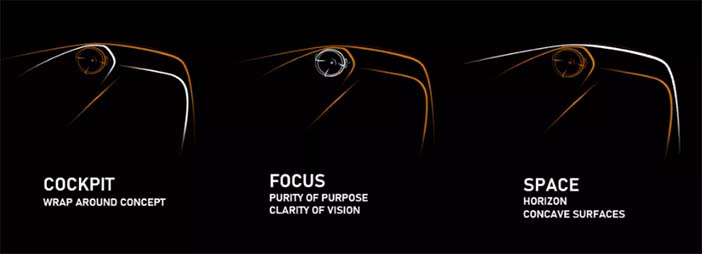
McLaren also says that future models will feature wraparound cockpits to provide a link to the brand’s F1 exploits, but promises that intelligent design, such as the use of concave surfaces and a horizon-like forward view will mean interiors will never feel claustrophobic. Sühlmann has come up with 5 design pillars that will guide the look and feel of every future McLaren. They’ll have to be ‘epic’ to grab our attention, like the aerodynamics of an F1 car do, ‘athletic’ to show us how efficiently they’re packaged and ‘functional’ because everything on a McLaren needs to have a purpose. The other pillars are ‘focused’, which could relate to ergonomics designed to help the driver use the available performance, and ‘intelligent’, because reliability, longevity and sustainability are just as important to owners as traveling at Mach III. McLaren didn’t say when we’d see the first fruits of this new design philosophy, but following last week’s announcement that Bahrain Mumtalakat Holding Company, the sovereign wealth fund of the Kingdom of Bahrain known as Mumtalakat, has upped its stake in the company from 60 to 100 percent, there’s a stronger chance that the company will be around to deliver on today’s tease. +++
+++ RENAULT plans to extract and recycle lithium and other materials from used electric vehicle batteries. If it achieves its aim, it will be the first European manufacturer to recycle batteries on a large scale. The chief executive of Renault’s environment unit The Future is Neutral (TFIN) Jean-Philippe Bahuaud revealed in an interview in Paris that the carmaker is in “advanced” discussions with specialist companies for battery material recycling. “In Europe, there is currently nobody who can claim to recycle used batteries in a closed-loop to reproduce nickel, cobalt and lithium to make new batteries”, Bahuaud told. Recycling the materials from used EV batteries doesn’t just benefit the environment. Important metals used in batteries account for up to 70% of a battery’s cost, which in turn can represent up to 40% of an EV’s cost. Recycling these metals and using them for new batteries will help Renault’s bottom line. Renault’s TFIN unit has already dipped its toe into the market. Production of the Zoé at the firm’s Flins factory near Paris will end next month and it will transition to producing partially recycled car components and reconditioned vehicles. It will also repair up to 9,000 batteries this year. These batteries and parts are sold at a 30% discount to new parts. It’s not all sunshine and rainbows in Renault’s electric world. For 2 years, Renault had been hoping to spin off its electric vehicle business Ampère. It canceled these plans in January. An IPO was scheduled for the first half of 2024 but Renault decided not to proceed due to “current equity market conditions”. It also said Ampere is performing better than expected and doesn’t need the cash injection as much as it had thought. +++
+++ VOLKSWAGEN R started in 2002 with the Golf R32. Then the Passat R came along in 2008, followed a year later by the Scirocco R, while the Polo R WRC landed in 2013. In recent years, ‘R’ has even been used for hot versions of the Arteon and T-Roc, Tiguan and Touareg SUVs. But in 2024, Volkswagen wants R to evolve into an independent brand. The plan is to open a dedicated Volkswagen R section at the Autostadt theme park in Wolfsburg. If you haven’t been there already, it’s a visitor attraction located near the company’s factory, similar in philosophy to the BMW Welt in Munich. Annually, about 2 million people visit the Autostadt and its multiple pavilions dedicated to Volkswagen Group brands, from Skoda and Seat to Audi and Lamborghini. An R pavilion will join them this summer. Fans of hot VWs will have the opportunity to check out concept cars and limited-run production models. Inevitably, there will be electric performance models on display. Volkswagen says the R lineup will gradually evolve in the coming years with amped-up EVs in the works. The process has already started with the Touareg R, complete with a plug-in hybrid V6 powertrain. However, there’s still life left in the ol’ internal combustion engine. The Golf R facelift is coming out this summer but sadly without a manual gearbox. That might be a dealbreaker for enthusiasts. Volkswagen’s decision to distance R (originally called Volkswagen Individual GmbH) from the main brand started in 2020 when it became a separate business unit. Elsewhere within the VW Group, Seat went a step further with its US-bound Cupra spin-off marque by introducing standalone models. Audi Sport is also a separate entity within Audi. As to what the future entails, Volkswagen has said the 9th generation Golf will be exclusively electric. Will that be the first electric R? Time will tell, but we’re likely going to see an electric GTI first. Spicy EVs are already part of the company’s portfolio since the GTX models have more power, including even the ID.Buzz GTX. In the meantime, R is doing better than ever as more than 35.000 cars were produced in 2023; a record for the brand. Since 2002, over 300.000 R-badged vehicles have been sold. +++

